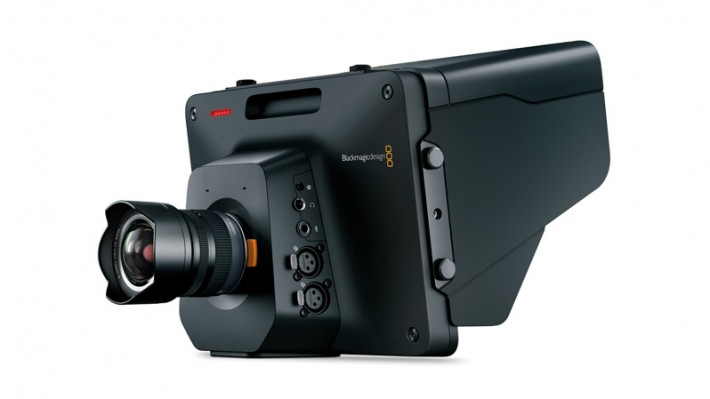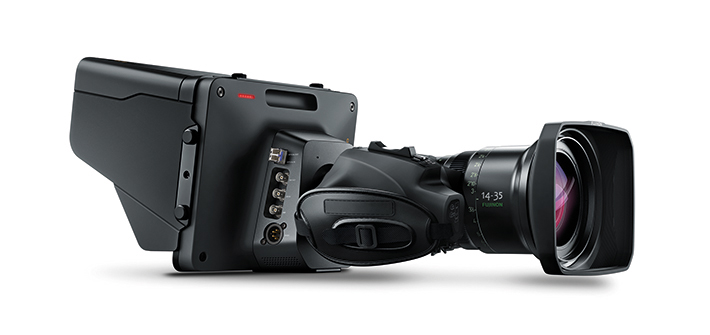Apparently Blackmagic has been busy this past year, as not only have we seen the URSA at NAB, but also they just announced the Studio Camera. Inside its magnesium alloy body you get a massive 10” viewfinder, 4 hour battery, talkback, tally indicators, phantom powered microphone connections and built in optical fiber and SDI connections that let you connect to your switcher with a single cable. The 1080p60 will retail for $1,995, while you can get 4K for $2,995.



You can get more info at Blackmagic.com, but here are the main features of the new camera:
- High resolution 1080HD in HD model and Ultra HD sized sensor in 4K model.
- Built in large 10 inch super bright wide viewing angle LCD viewfinder with sun shade.
- Built in optical fiber and regular SDI connections for camera output and monitoring input.
- Compatible with high quality Micro Four Thirds lenses. Compatible with other mounts via common third party adapters such as B4 broadcast lens mount.
- Built in, two way digital quality talkback using high quality affordable general aviation headsets.
- Includes front and rear tally indicators using tally over SDI protocol.
- Features all standard connections, including dual XLR balanced mic/line audio in with switchable phantom power, headphone and microphone jack for talkback, LANC remote control and standard 4 pin XLR broadcast standard DC 12V power connection.
- On screen menus for all camera settings.
- Supports 23.98, 24, 25, 29.97, 30 and up to 60 fps in HD model, up to 30 fps in 4K model.
- Compatible with ATEM range of live production switchers.
Blackmagic says the camera is available now, and like mentioned for US$1,995 for standard HD and US$2,995 for 4K.





![[Gear] Sony Reveals NEX-FS700, '4K Ready' and 240fps Camera Body](https://cdn.fstoppers.com/styles/small-16-9/s3/wp-content/uploads/2012/04/fs700-featured.jpg)

I dont know what to think :/
Love that price though
Would love to see what the profit margin is on this camera...its so cheap.
It is essentially a "cut-n-paste" product. All the parts and pieces (both hardware and software) were pre-existent in other products. So it was a matter of designing a new enclosure and dropping everything in. And the "CCU" is a virtual tab on their switcher "soft panel" heavily influenced by their DaVinci color correction product, but with none of the traditional CCU indicators/controls expected by experienced video production people.
I know next to nothing about TV production, but this has still got to be much cheaper than what was out there before, right? Does this seem like a viable solution for TV/Cable broadcast?
It is hard to make comparisons because there was NOTHING "out there before" in this category. This is essentially a whole new category. I'm sure with good lighting these will make quite usable cameras for a multi-cam studio (or remote) production. Certain things about this camera that are built-in to the design are BRILLIANT and unmatched within 10x the price. But there are other things where it looks like they ran out of steam and had to get the product out for NAB. Perhaps some of them can be corrected with firmware.
WTF is it with these guys and non-interchangable batteries?
studio cam.... don't know anybody that needs a battery in a studio situation
So why is there a battery in it in the first place?
momentary power loss, moving across the room, etc.
Looks like rehashed tech to me...
so? it's a broadcast cam for $2k. 95% has to be rehashed tech to be that cheap. Really all they are doing is updating the ergonomics.
Well, that's kinda my point. There's no need for it anymore. How many people are watching on CRTs, and do they matter?
Well, I can see perhaps a 5% action safe, as you've pointed out, but that's about it. You don't need a 10% action safe, and you definitely don't need a title safe anymore.
BlackMagic is doing great job with these cameras, just amazing! But the reason why this is so cheap: This doesn't record, this need external recorder! That's why there's Fiber connections and SDI. And if someone whines about the battery, then find a proper, high quality fiber-recorder with battery that lasts longer than 4 hours...
Indeed, there appears to be no white balance. The "virtual CCU" appears to have been designed by the DaVinci crew. Heavy on color tweaking, and very light (or non-existent) on all the other traditional CCU controls needed for proper high quality production. I see these going into churches, etc, where people are DIY productions. But I can't see using these for broadcast applications.
The demonstration set for all their cameras is very "favorably" lit. Flat and high levels. No opportunity to see how it performs in high/low lights, etc. Compare with the very "dramatic" lighting in the old-school camera booths (Sony, et.al.) where you can really see how their gear handles real world situations. And even with the favorable lighting, the studio camera didn't have that "pop" that you see from higher-end cameras.
No touch screen? I can't swipe using my fingers?